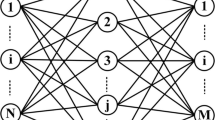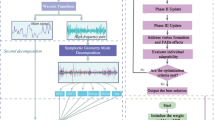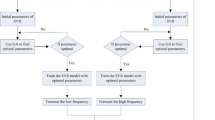Abstract
Accurate prediction of ultra-short-term wind speed is important in many applications. Because of the different patterns of wind speed, researchers have indicated that a multi-scale prediction method based on wavelet algorithms could improve forecasting. However, traditional multi-scale methods that directly synthetize results of different-scale components may reduce forecasting accuracy because of error accumulation. In this paper, a multi-scale synthesis strategy that takes into account the predictability of different scales is proposed. As the correlation length of each frequency sub-series is different, prediction models are constructed for each frequency sub-series using different numbers of prediction steps. Finally, based on two wind farms in different regions of China and different basic forecast models, eight experiments are performed using real-world wind speed data. Experimental results show that the proposed multi-scale synthesis method has better performance than traditional multi-scale forecasting methods that use direct synthetizing strategies, indicating its utility in wind engineering applications.


























Similar content being viewed by others
References
Daniel, A.R., Chen, A.A.: Stochastic simulation and forecasting of hourly average wind speed sequences in Jamaica. Solar Energy 46(1), 1–11 (1991)
Huang, Z., Chalabi, Z.S.: Use of time-series analysis to model and forecast wind speed. J. Wind Eng. Ind. Aerod. 56(2), 311–322 (1995)
Soman, S.S., Zareipour, H., Malik, O., Mandal, P.A: Review of wind power and wind speed forecasting methods with different time horizons. In: IEEE North American Power Symposium. pp. 1–8 (2010)
Fonte, P.M., Silva, G.X., Quadrado, J.C.: Wind speed prediction using artificial neural networks. WSEAS Trans. Syst. 4(4), 379–384 (2005)
Lei, M., Shiyan, L., Chuanwen, J., Hongling, L., Yan, Z.: A review on the forecasting of wind speed and generated power. Renew. Sustain. Energy Rev. 13(4), 915–920 (2009)
Hu, Q., Su, P., Yu, D., Liu, J.: Pattern-based wind speed prediction based on generalized principal component analysis. IEEE Trans. Sustain. Energy 5(3), 866–874 (2014)
Osório, G.J., Matias, J.C.O., Catalão, J.P.S.: Short-term wind power forecasting using adaptive neuro-fuzzy inference system combined with evolutionary particle swarm optimization, wavelet transform and mutual information. Renew. Energy 75, 301–307 (2015)
Ummels, B.C., Gibescu, M., Pelgrum, E., Kling, W.L.: Impacts of wind power on thermal generation unit commitment and dispatch. IEEE Trans. Energy Convers. 22(1), 44–51 (2007)
Wu, B., et al.: Wind power prediction system for wind farm based on auto regressive statistical model and physical model. J. Renew. Sustain. Energy 6.1, 013101 (2014)
Kuik, G.V., Ummels, B., Hendriks, R.: Sustainable Energy Technologies. Springer, Amsterdam (2007)
Kusiak, A., Zheng, H., Song, Z.: Wind farm power prediction: a data-mining approach. Wind Energy 12(3), 275–293 (2009)
Golding, B.W.: The meteorological office mesoscale model. Meteorol. Mag. 119(1414), 81–96 (1990)
Machenhauer, B. (ed).: HIRLAM final report. Danish Meteorological Institute (1988)
Pielke, R.A., et al.: A comprehensive meteorological modeling system—RAMS. Meteorol. Atmos. Phys. 49(1–4), 69–91 (1992)
Skamarock, W.C., Klemp, J.B., Dudhia, J., Gill, D.O., Barker, D.M., Wang, W., Powers, J.G.: A description of the advanced research WRF version 2. NCAR/TN-468 (2005)
Kariniotakis, G.N., Stavrakakis, G.S., Nogaret, E.F.: Wind power forecasting using advanced neural networks models. IEEE Trans. Energy Convers. 11(4), 762–767 (1996)
Kim, D.H., Gee, N.L., Osoon, K.: Wind power prediction at southwest coast of Korea from measured wind data. J. Renew. Sustain. Energy 6.6, 063101 (2014)
Mohandes, M.: Support vector machines for short-term electrical load forecasting. Int. J. Energy Res. 26(4), 335–345 (2002)
Thordarson, F.Ő.: Conditional weighted combination of wind power forecasts. Wind Energy 13(8), 751–763 (2011)
De Giorgi, M.G.: Error analysis of short term wind power prediction models. Appl. Energy 88(4), 1298–1311 (2011)
Krishnamurti, T.N., et al.: Improved weather and seasonal climate forecasts from multimodel superensemble. Science 285(5433), 1548–1550 (1999)
Gneiting, T., Raftery, A.E.: Weather forecasting with ensemble methods. Science 310(5746), 248–249 (2005)
Katsigiannis, Y.A., Tsikalakis, A.G., Georgilakis, P.S., Hatziargyriou, N.D.: Improved Wind Power Forecasting Using a Combined Neuro-fuzzy and Artificial Neural Network Model, pp. 105–115. Springer, Heidelberg (2006)
Catalao, J.P.S., Pousinho, H.M.I., Mendes, V.M.F.: An artificial neural network approach for short-term wind power forecasting in Portugal. In Proc. IEEE 15th Int. Conf. Intell. Syst. Appl. Power Syst., 2009, pp. 1–5
Catalao, J.P.S., Pousinho, H.M.I., Mendes, V.M.F.: Hybrid intelligent approach for short-term wind power forecasting in Portugal. IET Renew. Power Gener. 5(3), 251–257 (2011)
Moonen, P., Dorer, V., Carmeliet, J.: Effect of flow unsteadiness on the mean wind flow pattern in an idealized urban environment[J]. J. Wind Eng. Ind. Aerodyn. 104, 389–396 (2012)
Hu, Q., Zhang, R., Zhou, Y.: Transfer learning for short-term wind speed prediction with deep neural networks. Renew. Energy 85, 83–95 (2016)
Reisyan, G.D.: Brain Science and Emotion Research. Neuro-Organizational Culture, pp. 77–166. Springer, Berlin (2016)
Liu, H., et al.: A hybrid statistical method to predict wind speed and wind power. Renew. Energy 35(8), 1857–1861 (2010)
Catalão, J.P.S., Pousinho, H.M.I., Mendes, V.M.F.: Short-term wind power forecasting in Portugal by neural networks and wavelet transform. Renew. Energy 36(4), 1245–1251 (2011)
Catalao, J.P.S., Pousinho, H.M.I., Mendes, V.M.F.: Hybrid intelligent approach for short-term wind power forecasting in Portugal. IET Renew. Power Gener. 5(3), 251–257 (2011)
Wang, J.-Z., Wang, Y., Jiang, P.: The study and application of a novel hybrid forecasting model—a case study of wind speed forecasting in China. Appl. Energy 143, 472–488 (2015)
Wang, L., Dong, L., Hao, Y., Liao, X.: Wind power prediction using wavelet transform and chaotic characteristics. In: Proc. IEEE World Non-Grid-Connected Wind Power Energy Conf., 2009, pp. 1–5
Xu, Z. et al.: Crowdsourcing based description of urban emergency events using social media big data. IEEE Trans. Cloud Comput. doi:10.1109/TCC.2016.2517638
Luo, X., Xu, Z., Yu, J., Chen, X.: Building association link network for semantic link on web resources. IEEE Trans. Autom. Sci. Eng. 8(3), 482–494 (2011)
Chen, N., Zheng Q., Xiaofeng M.: Multistep wind speed forecasting based on wavelet and gaussian processes. Math. Probl. Eng. (2013)
Liu, H., et al.: A hybrid model for wind speed prediction using empirical mode decomposition and artificial neural networks. Renew. Energy 48, 545–556 (2012)
Zhang, G., Yonggang, W., Liu, Y.: An advanced wind speed multi-step ahead forecasting approach with characteristic component analysis. J. Renew. Sustain. Energy 6(5), 053139 (2014)
Guo, Z., Zhao, W., Lu, H., et al.: Multi-step forecasting for wind speed using a modified EMD-based artificial neural network model. Renew. Energy 37(1), 241–249 (2012)
Liu, H., Tian, H-q, Li, Y-f: An EMD-recursive ARIMA method to predict wind speed for railway strong wind warning system. J. Wind Eng. Ind. Aerodyn. 141, 27–38 (2015)
Ren, Y., Suganthan, P.N., Narasimalu, S.: A comparative study of empirical mode decomposition-based short-term wind speed forecasting methods. IEEE Trans. Sustain. Energy 6.1, 236–244 (2015)
Xu, Z., et al.: Semantic based representing and organizing surveillance big data using video structural description technology. J. Syst. Softw. 102, 217–225 (2015)
Wang, J., Zhang, W., Li, Y., et al.: Forecasting wind speed using empirical mode decomposition and Elman neural network. Appl. Soft Comput. 23, 452–459 (2014)
Ren, Y., Suganthan, P., Narasimalu S.: A novel empirical mode decomposition with support vector regression for wind speed forecasting. (2014)
Mix, D.F., Kraig, J.O.: Elements of Wavelets for Engineers and Scientists. Wiley, New York (2003)
Mallat, S.G.: A theory for multiresolution signal decomposition: the wavelet representation. IEEE Trans. Pattern Anal. Machine Intell. 11(7), 674–693 (1989)
Deng, Y., Hu, Y., Meng, X., Zhu, Y., Zhang, Z., Han, J.: Predictively booting nodes to minimize performance degradation of a power-aware web cluster. Clust. Comput. 17(4), 1309–1322 (2014)
Zou, Q.: Reexamining anomaly temporal behaviors in SPEC CPU workloads: self-similar or not? Cluster Comput. 17(4), 1427–1441 (2014)
Peng, H., Long, F., Ding, C.: Feature selection based on mutual information criteria of max-dependency, max-relevance, and min-redundancy. IEEE Trans. Pattern Anal. Machine Intell. 27(8), 1226–1238 (2005)
Vapnik, V.N., Vlamimir, V.: Statistical Learning Theory, vol. 1. Wiley, New York (1998)
Monge, D.A., Holec, M., Železný, F., Garino, C.G.: Ensemble learning of runtime prediction models for gene-expression analysis workflows. Cluster Comput. 18(4), 1317–1329 (2015)
Suykons, J.A.K., et al.: Least Squares Support Vector Machines. World Scientific, London (2002)
Yang, B., Xu, J., Yang, J., Li, M.: Localization algorithm in wireless sensor networks based on semi-supervised manifold learning and its application. Cluster Comput. 13(4), 435–446 (2010)
Suykens, J.A.K., De Brabanter, J., Lukas, L., et al.: Weighted least squares support vector machines: robustness and sparse approximation [J]. Neurocomputing 48(1), 85–105 (2002)
Acknowledgments
This work was supported by National Program on Key Basic Research Project (973 Program) of China under Grant 2012CB215201.
Author information
Authors and Affiliations
Corresponding author
Ethics declarations
Conflicts of interest
The authors declare that there is no conflict of interest regarding the publication of this paper.
Rights and permissions
About this article
Cite this article
Wan, J., Ren, G., Liu, J. et al. Ultra-short-term wind speed prediction based on multi-scale predictability analysis. Cluster Comput 19, 741–755 (2016). https://doi.org/10.1007/s10586-016-0554-0
Received:
Revised:
Accepted:
Published:
Issue Date:
DOI: https://doi.org/10.1007/s10586-016-0554-0




